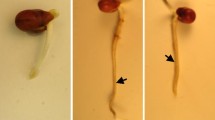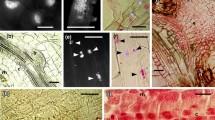Abstract
Maize (Zea mays L. cv. Thermo) root segments were treated for 24 h with 100 μg mL−1 of zearalenone and its derivatives α- and β-zearalenol. The mycotoxin treatment resulted in cell death which was evident by Evans blue staining and was accompanied by DNA release/fragmentation. Mycotoxin-induced programmed cell death (MPCD) was abolished by sub-micromolar concentrations of caspase-specific peptide inhibitors pointing to a MPCD mechanism similar to animal apoptosis. Here we demostrate that exogenous ethylene and ethylene precursor (aminocyclopropane-1-carboxylic acid; ACC) substantially blocked MPCD while the ethylene biosynthesis inhibitor aminoethoxyvinylglycine (AVG) did not markedly reduce cell death rate. In addition, Western blot analyses revealed that MPCD was induced via ethylene-regulated expression of DAD1 protein. Pre-treatment of root segments with inhibitors of phospholipase C and D signalling pathway intermediates significantly reduced the rate of MPCD. Treatment with mastoparan and lyso-phosphatidic acid (L-PA), G protein activator and analogue of the lipid second messenger phosphatidic acid (PA), respectively, stimulated cell death. Furthermore, application of lipid and protein kinase inhibitors (wortmannin, Go 6983, staurosporine) also reduced cell death, indicating that various kinases are a part of signalling cascade involved in MPCD. Taken together, the results presented in this paper provide direct evidence that MPCD exhibits formal apoptotic-like features, involves caspase-mediated pathway and is regulated via ethylene and phospholipid signal transduction pathways.
Similar content being viewed by others
References
Apte S.S., Mattei M.G., Seldin M.F. & Olsen B.R. 1995. The highly conserved defender against the death 1 (DAD1) gene maps to human chromosome 14q11-q12 and mouse chromosome 14 and has plant and nematode homologs. FEBS Lett. 363: 304–306.
Asai T., Stone J.M., Heard J.E., Kovtun Y., Yorgey P., Sheen J. & Ausubel F.M. 2000. Fumonisin B1-induced cell death in Arabidopsis protoplasts requires jasmonate-, ethylene-, and salicylate-dependent signaling pathways. Plant Cell 12: 1823–1836.
Berthiller F., Werner U., Sulyok M., Krska R., Hauser M.-T. & Schumacher R. 2006. Liquid chromatography coupled to tandem mass spectrometry (LC-MS/MS) determination of phase II metabolites of the mycotoxin zearalenone in the model plant Arabidopsis thaliana. Food Addit. Contam. 23: 1194–1200.
Biesaga-Kosćielniak J. & Filek M. 2010. Occurrence and physiology of zearalenone as a new plant hormone, pp. 419–435. In: Lichtfouse E. (ed.), Sociology, organic farming, climate change and soil science. Springer, Berlin.
Choi M.S., Kim W., Lee C. & Oh C.S. 2013. Harpins, multifunctional protein secreted by gram-negative plant-pathogenic bacteria. Mol. Plant Microbe In. 26: 1115–1122.
Coffeen W.C. & Wolpert T.J. 2004. Purification and characterization of serine proteases that exhibit caspase-like activity and are associated with programmed cell death in Avena sativa. Plant Cell 16: 857–873.
Dong Y.H., Zhan X.C., Kvarnheden A., Atkinson R.G., Morris B.A. & Gardner R.C. 1998. Expression of a cDNA from apple encoding a homologue of DAD1, an inhibitor of programmed cell death. Plant Sci. 139: 165–174.
Engelhardt G., Zill G., Wohner B. & Wallnöfer P.R. 1988. Transformation of the Fusarium mycotoxin zearalenone in maize cell suspension cultures. Naturwissensch. 75: 309–310.
Engelhardt G., Ruhland M. & Wallnöfer P.R. 1999. Metabolism of mycotoxins in plants. Adv. Food Sci. 21: 71–78.
Gareis M., Bauer J., Thiem J., Plank G., Grabley S. & Gedek B. 1990. Cleavage of zearalenone glycoside, a “masked” myco-toxin during digestion in swine. J. Vet. Med. B. 37: 236–240.
Gillaspy G.E., Keddie J.S., Oda K. & Gruissem W. 1995. Plant inositol monophosphatase is a lithium-sensitive enzyme encoded by a multigene family. Plant Cell 7: 2175–2185.
Hoffman T., Schmidt J.S., Zheng X. & Bent A.F. 1999. Isolation of ethylene-insensitive soybean mutants that are altered in pathogen susceptibility and gene-for-gene disease resistance. Plant Physiol. 119: 935–950.
Jiao J., Zhou B., Zhu X., Gao Z. & Liang Y. 2013. Fusaric acid induction of programmed cell death modulated through nitric oxide signalling in tobacco suspension cells. Planta 238: 727–737.
Jiao J., Sun L., Zhou B., Gao Z., Hao Y., Zhu X. & Liang Y. 2014. Hydrogen peroxide production and mitochondrial dysfunction contribute to the fusaric acid-induced programmed cell death in tobacco cells. J. Plant Physiol. 171: 1197–1203.
Jones A.M. & Dangl J.L. 1996. Logjam at the Styx: programmed cell death in plants. Trends Plant Sci. 1: 114–119.
Kelleher D.J. & Gilmore R. 2006. An evolving view of the eu-karyotic oligosaccharyltransferase. Glycobiology 16: 47–62.
Kosćielniak J., Biesaga-Kosćielniak J., Janeczko A., Filek W. & Kalaji H.M. 2009. Can the Gibberella zae toxin zearalenone affect the photosynthetic productivity and increase yield formation in spring wheat and soybean plants. Photosynthetica 47: 586–594.
Kumar N. & Sinha K.K. 1995. Effect of zearalenone on some physiological and biochemical processes of gram and mustard seeds, pp. 149–162. In: Roy A.K. & Sinha K.K. (eds), Recent advances in phytopathological researches. M.D. Publications PVT, New Delhi, India.
Krzymowska M., Konopka-Postupolska D., Sobczak M., Macioszek V., Ellis B.E. & Hennig J. 2007. Infection of tobacco with different Pseudomonas syringae pathovars leads to distinct morphotypes of programmed cell death. Plant J. 50: 253–264.
Liu Y., Schiff M., Czymmek K., Talloczy Z., Levine B. & Dinesh-Kumar S.P. 2005. Autophagy regulates programmed cell death during the plant innate immune response. Cell 121: 567–577.
Meng F.J., Han Y.Z., Que Y.M. & Wang H. 1992. Zearalenone, a key substance controlling plant development, pp. 291–297. In: Karssen C.M., Van Loon L.C. & Vreuggdennilcedes D. (eds), Advances in Plant Regulation. Kluwer, Dordrecht.
Mueller-Roeber B. & Pical C. 2002. Inositol phospholipid metabolism in Arabidopsis: characterized and putative iso-forms of inositol phospholipid kinase and phosphoinositide-specific phospholipase C. Plant Physiol. 130: 22–46.
Munnik T. & Meijer H.J. 2001. Osmotic stress activates distinct lipid and MAPK signalling pathways in plants. FEBS Lett. 498: 172–178.
Munnik T., Arisz S.A., De Vrije T. & Musgrave A. 1995. G protein activation stimulates phospholipase D signaling in plants. Plant Cell Online 7: 2197–2210.
Murashige T. & Skoog F. 1962. A revised medium for rapid growth and bio assays with tobacco tissue cultures. Physiol. Plantarum 15: 473–497.
Murphy A.M., Otto B., Brearley C.A., Carr J.P. & Hanke D.E. 2008. A role for inositol hexakisphosphate in the maintenance of basal resistance to plant pathogens. Plant J. 56: 638–652.
Norman-Setterblad C., Vidal S. & Palva E.T. 2000. Interacting signal pathways control defence gene expression in Arabidopsis in response to cell wall-degrading enzymes from Erwinia carotovora. Mol. Plant Microbe In. 13: 430–438.
Pennel R.I. & Lamb C. 1997. Programmed cell death in plants. Plant Cell 9: 1157–1168.
Plett J.M., Cvetkovska M., Makenson P., Xing T. & Regan S. 2009. Arabidopsis ethylene receptors have different roles in Fumonisin B1-induced cell death. Physiol. Mol. Plant Pathol. 74: 18–26.
Repka V. 2006. Early defence responses induced by two distinct elicitors derived from a Botrytis cinerea in grapevine leaves and cell suspensions. Biol. Plantarum 50: 94–106.
Repka V., Fiala R., Luxová M. & Pavlovkin J. 2014. Responses of maize root cells to zearalenone and its derivatives α-zearalenol and β-zearalenol. Eur. J. Plant Pathol. 138: 787–797.
Richberg M.H., Aviv D.H. & Dangl J.L. 1998. Dead cell do tell tales. Curr. Opin. Plant Biol. 1: 480–485.
Ruelland E., Kravets V., Derevyanchuk M., Martinec J., Zachowskia A. & Pokotylo I. 2015. Role of phospholipid signalling in plant environmental responses. Environ. Exp. Bot. 114: 129–143.
Schollenderger M., Drochner W. & Muüller H.M. 2007. Fusarium toxins of the scirpentriol subgroup: a review. Mycopathol. 165: 101–108.
Shiskova S. & Dubrovsky J.G. 2005. Developmental programmed cell death in primary roots of Sonoran desert Cactaceae. Amer. J. Bot. 92: 1590–1594.
Singh V.K. & Upadhyay R.S. 2014. Fusaric acid induced cell death and changes in oxidative metabolism of Solanum lycopersicum L. Bot. Stud. 55: 66.
Testerink C. & Munnik T. 2005. Phosphatidic acid: a multifunctional stress signaling lipid in plants. Trends Plant Sci. 10: 367–375.
Testerink C., Larsen P.B., McLoughlin F., van der Does D., van Himbergen J.A. & Munnik T. 2008. PA, a stress-induced short cut to switch-on ethylene signalling by switching-off CTR1? Plant Signal. Behav. 3: 681–683.
Thomma B.P., Eggermont K., Tierens K.F. & Broekaert W.F. 1999. Requirement of functional ethylene-insensitive 2 gene for efficient resistance of Arabidopsis to infection by Botrytis cinerea. Plant Physiol. 121: 1093–1102.
Vianello M. & Macri F. 1978. Inhibition of plant cell membrane transport phenomena induced by zearalenone. Planta 143: 51–57.
Vianello M. & Macri F. 1981. Effect of zearalenone (F-2) on pea steam, maize root and rat liver mitochondria. Planta 153: 443–446.
Yamada T., Takatsu Y., Kasumi M., Marubashi W. & Ichimura K. 2004. A homolog of the defender against apoptotic death gene (DAD1) in senescing gladiolus petals is down-regulated prior to the onset of programmed cell death. J. Plant Physiol. 161: 1281–1283.
Zhang X., Wu Q., Cui S., Ren J., Qian W., Yang Y., He S., Chu J., Sun X., Yan C., Yu X. & An C. 2015. Hijacking of the jasmonate pathway by the mycotoxin fumonisin B1 (FB1) to initiate programmed cell death in Arabidopsis is modulated by RGLG3 and RGLG4. J. Exp. Bot. 66: 2709–2721.
Zinedine A., Soriano J.M., Molt˜o J.C. & Maňes J. 2007. Review on the toxicity, occurrence, metabolism, detoxification, regulations and intake of zearalenone: an oestrogenic mycotoxin. Food Chem. Toxicol. 45: 1–18.
Zonia L. & Munnik T. 2006. Cracking the green paradigm: functional coding of phosphoinositide signals in plant stress responses, pp. 207–237. In: Majunder A. & Biswas B. (eds), Subcellular Biochemistry Vol. 39: Biology of Inositols and Phosphoinositides. Kluwer/Plenum Publishers, Dordrecht.
Author information
Authors and Affiliations
Corresponding author
Rights and permissions
About this article
Cite this article
Repka, V., Fiala, R. & Pavlovkin, J. Role of ethylene and phospholipid-mediated signalling in mycotoxin-induced programmed cell death in the apical part of maize roots. Biologia 72, 378–387 (2017). https://doi.org/10.1515/biolog-2017-0040
Received:
Accepted:
Published:
Issue Date:
DOI: https://doi.org/10.1515/biolog-2017-0040




